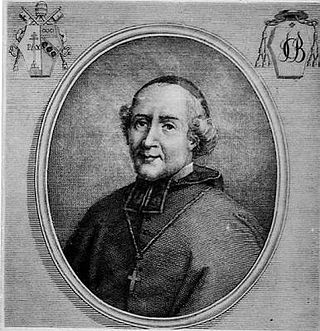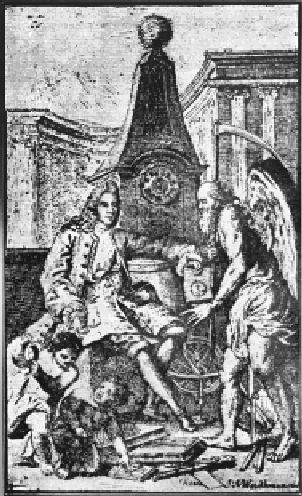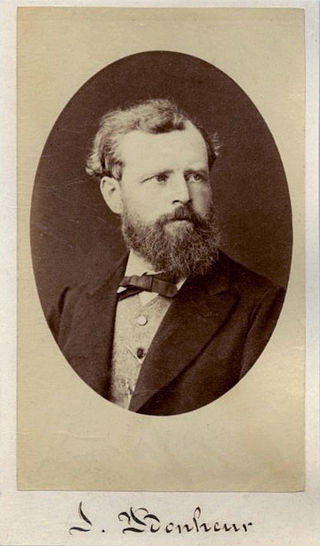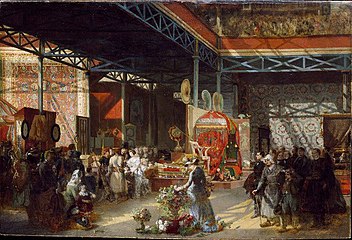Biography
His father, Victor, was a mason. At the age of fourteen, he left his family to live with an uncle in Paris. His initial artistic training came in the workshops of artists who have now been forgotten but, in 1827, he was able to work with Auguste Couder. His first exhibition came four years later, when he presented an equestrian portrait of Napoleon. After that, he worked as assistant to Jean Alaux, restoring various monumental paintings. This led to his participation in restorative work being done at the Château de Versailles.
From 1834 to 1837, he created several battle paintings for the Musée de l'Histoire de France at Versailles. Then, from 1838 to 1842, he received orders directly from the Royal Family. He also had numerous customers among the French bourgeoisie.
During a trip to Burgundy in 1845, he developed an interest in the creation and restoration of stained glass windows. He trained himself by participating in projects at Notre-Dame-des-Blancs-Manteaux and Saint-Eustache, then undertook restorative work on his own at several churches, including Saint-Étienne-du-Mont, Saint-Nicolas-du-Chardonnet, Saint-Médard [ fr ] and Saint-Merri.
In 1851, he had a showing at the Great Exhibition in London. That same year, he hired two assistants, Annette and Sophie Coppée, sisters of the poet François Coppée. The following year he married Sophie. In addition to giving him three girls and a boy, she became an indispensable part of the window production process and may have created some entirely on her own. Eventually, between 1864 and 1866, they would work on windows at the Louvre. This was followed by windows at the parish church in his hometown.
He continued to paint, exhibiting at the Exposition Universelle (1855), the Exposition Universelle (1867) and the Exposition Universelle (1878).
After his death, his studio was closed. His son, Savinien, had died in 1854 and his daughters had not learned the trade from their mother. He and Sophie are buried together in Mont-Saint-Sulpice.

Denis-Antoine-Luc, comte de Frayssinous was a French prelate and statesman, orator and writer. He was the eighth member elected to occupy Seat 3 of the Académie Française in 1822.

The Church of Saint-Sulpice is a Roman Catholic church in Paris, France, on the east side of Place Saint-Sulpice, in the Latin Quarter of the 6th arrondissement. It is only slightly smaller than Notre-Dame and thus the second-largest church in the city. It is dedicated to Sulpitius the Pious. Construction of the present building, the second church on the site, began in 1646. During the 18th century, an elaborate gnomon, the Gnomon of Saint-Sulpice, was constructed in the church.

Jean René Bazaine was a French painter, designer of stained glass windows and writer. He was the great great grandson of the English Court portraitist Sir George Hayter.

Jean-François-Thérèse Chalgrin was a French architect, best known for his design for the Arc de Triomphe, Paris.

Jean de Dieu-Raymond de Cucé de Boisgelin was a French prelate, statesman and cardinal. The Boisgelin of Cucé are the Cadet branch of the maison de Boisgelin). His cousin is the famous author Louis de Boisgelin.

Michel Gigon is a French painter and stained-glass window designer. He began his artistic career in 1953.

The Église Saint-Augustin de Paris is a Roman Catholic church located at 46 boulevard Malesherbes in the 8th arrondissement of Paris. The church was built between 1860 and 1871 by the Paris city chief architect Victor Baltard. It was the first church in Paris to combine a cast-iron frame, fully visible, with stone construction. It was designed to provide a prominent landmark at the junction of two new boulevards built during Haussmann's renovation of Paris under Napoleon III. The closest métro station is Saint-Augustin

St Francis Xavier Church (French: Église Saint-François-Xavier or Église Saint-François-Xavier-des-Missions-étrangères is a parish Roman Catholic church in the 7th arrondissement of Paris dedicated to Francis Xavier, the patron saint of missions. Built in the late 19th century, It gave its name to the nearby Metro station Saint-François-Xavier. It contains the tomb of Madeleine Sophie Barat, a French saint of the Catholic Church and founder of the Society of the Sacred Heart, a worldwide religious institute of educators.It also known for its collection of Italian Baroque and Mannerist paintings, including a work by Tintoretto.

Eugène-Louis Lequesne was a French sculptor. Lequesne was born and died in Paris. In 1841, he entered the École nationale des beaux-arts, in James Pradier's workshop. In 1843, he won the second Prix de Rome, and in 1844 the first prize, with a plaster bas-relief entitled Pyrrhus tuant Priam. He lived at the Académie de France à Rome from 1844 to 1849, alongside Jean-Louis Charles Garnier. In 1855, he was awarded the Great Prize for sculpture at the Exposition Universelle, and received the Légion d'honneur.

Henry Sully (1680–1729) was an English clockmaker. He was an apprentice and then journeyman for celebrated English clockmaker and watchmaker Charles Gretton. He lived in France for many years.

Isidore Jules Bonheur, best known as one of the 19th century's most distinguished French animalier sculptors. Bonheur began his career as an artist working with his elder sister Rosa Bonheur in the studio of their father, drawing instructor Raymond Bonheur. Initially working as a painter, Isidore Jules Bonheur made his Salon debut in 1848.
Édouard Didron (1836-1902) was a French stained glass artist and art writer.

Joseph Villiet was a French master stained glass artist born in Ébreuil, France. He trained at the atelier of Émile Thibaud and Étienne Thevenot, at Clermont-Ferrand. In 1852, he relocated to Bordeaux where he worked until his death in 1877.

Frédéric Montenard was a French landscape and seascape painter.

Nicolas Lenglet Du Fresnoy was a French scholar, historian, geographer, philosopher and bibliographer of alchemy.

Philippe Chaperon was a French painter and scenic designer, particularly known for his work at the Paris Opera. He produced stage designs for the premieres of numerous 19th-century operas, including Verdi's Don Carlos and Aida, Massenet's Le Cid, Saint-Saëns's Henri VIII, part two of Berlioz's Les Troyens and the first performances in France of Verdi's Otello and Rigoletto and Wagner's Tannhäuser.

Eugène Goyet, was a French artist. Beginning in 1827 his work was regularly selected for exhibition in the annual Paris Salon. He achieved his greatest success as a painter of religious subjects, with his paintings of Christ and various saints installed in churches and public buildings across France. A successful portrait painter, his most prestigious commission was his 1847 portrait of Pope Pius IX. He was the son of self-taught artist Jean-Baptiste Goyet, and husband of the pastel portrait artist Zoé Goyet.

Charles-Caius Renoux was a French painter, lithographer, and illustrator. He first achieved success with paintings of medieval churches, particularly the ruins of cloisters and monasteries destroyed during the French Revolution, works for which he is still best known. Renoux also painted landscapes, large-scale battle scenes, and historical subjects, works which uniquely prepared him for the final phase of his career, the creation of spectacular dioramas, the “moving pictures” of the era. He also taught at the École des Beaux-Arts in Paris; his notable students included Narcisse Berchère and Hector Hanoteau.

Paul Georges Louis Berger was a French engineer, politician, and art enthusiast.
Stéphane Kreienbühl, known as Stéphane Belzère, is a Franco-Swiss painter. He lives and works between Paris and Basel.






















